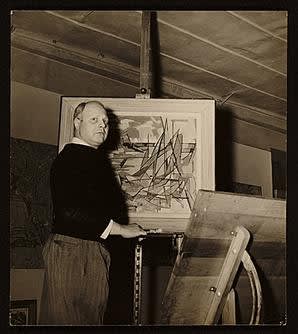Considered one of the earliest American abstractionists, Carl Holty is known for his painting style that combines European modernism and abstract expressionism. Holty, a native of Germany, came to the United States as an infant and grew up in Milwaukee, Wisconsin. He studied at the Art Institute of Chicago and the National Academy of Design in New York, and then went to Munich to study with the painter Hans Hofmann. He wrote of the experience: “No one had ever talked to me about conceptual drawing . . . Hofmann did. And the world opened up just like that.” Holty’s early paintings were strongly influenced by synthetic cubism and the works of Juan Gris and Pablo Picasso. Though his later style was more purely abstract, Holty’s subjects were always related to the natural world. Beginning in the 1930s, Holty used tape to create his hallmark crisp, clean-edged painted forms. Holty exhibited consistently until his death in 1973, including numerous showings at the Whitney Museum of American Art. His work underwent many stylistic shifts over the years, though he maintained a vibrant and arresting color palette.
